Chrystina Häuber
Das Archäologische Informationssystem `AIS ROMA´: Esquilin, Caelius, Capitolium, Velabrum, Porta Triumphalis, Bullettino della Commissione Archeologica Comunale (BullCom) 106, 2005, S. 9-59.
Abstract
This article presents preliminary maps (`Arbeitskarten´) created with data contained in the Archaeological Information System `AIS ROMA´. Those maps were compiled for two reasons: to support topographical studies like those offered here, and in order to clarify the provenances of `old´ finds, especially of ancient scultures and inscriptions, reported in Rome since the Middle Ages. Such reports often mention ancient ruins, names of streets, churches or of other toponyms which no longer exist but are known from old maps, for example G. B. Nolli's very precise map of 1748, which inter alia is integrated here. Chapter I introduces our technical methods, Chapter II the topographical methods, which are basically the same as traditional `paper-based methods´, but adapted for computer use. The sample area comprises the Esquiline and the Caelian, focussing on the reconstruction of the course of the so-called Servian city Wall of the 4th century BC. Chapter III is dedicated to recent reconstructions of the Capitolium and to its immediate surroundings. The sample maps integrate the reconstruction of the ancient orography of the Capitoline hill by A. Ammerman and N. Terrenato with some recent reconstructions of the area Capitolina (the temenos of the temple of Iuppiter Optimus Maximus), almost all of which (following the ideas of A.J.C.A. Dureau de La Malle, Th. Mommsen, Ch. Hülsen, A.M. Colini, L. Cozza and F. Coarelli) have located the temples of Fides and of Ops close to each other and within the `western half´ of the area Capitolina; variously identifying them with three temples shown on fragments of the Severan marble plan (nos. 31a-c and 499/ 31kk).
This study concludes that the temples of Fides and of Ops cannot be located more precisely than "near the temple of Iuppiter Optimus Maximus" and the temple of Ops no more precisely than "in Capitolio". The two temples visible on fragments nos. 31a-c of the Severan marble plan stood on a terrace of the Capitolium ca. 10-20 m below the hilltop, but both must remain anonymous. Fragment no. 499/ 31kk cannot be located on the Capitolium at all, therefore, the temple it depicts is not the temple of Fides either. Pirro Ligorio's documentation of `excavations´, comprising a reconstructed groundplan of a temple, drawings of an inscription and of architectural fragments, as well as a written report describing those finds, does not relate to the temple of Fides, as believed by Ch. Reusser, but instead to the temple of Saturn and its immediate neighbourhood. The famous fragmentary inscriptions - some of which were found near S. Omobono - recording dedications by Asiatic kings, cities and communities, which many scholars since Colini have attributed to the temple of Fides, are in fact dedications to either Iuppiter Optimus Maximus or to the populus Romanus or to the two combined (A.W. Lintott). Consequently, the architectural fragments which were also found near S. Omobono and come from one (or more likely two) temples, do not necessarily belong to the temple of Fides; they too must remain anonymous. Two fragmentary acrolithic statues found near S. Omobono, one of which was identified by Reusser as the cult statue of Fides, may just as well have stood in a temple near where they were found, e.g. the Temple of Felicitas in the Velabrum. Other sculptures which have been interpreted with regard to alleged locations of the temples of Fides and of Ops and which should therefore be reconsidered are: the old `market woman´ in the Metropolitan Museum of Art in New York, the statue of Aristogeiton found near S. Omobono, and the head of the `Hercules by Polykles´, both in the Musei Capitolini, Centrale Montemartini. Lastly, an attempt is made to reconstruct the Porta Triumphalis".
Original Abstract Seite 9-10
Die großen Karten dieses Bandes (Figs. 3.5; 3.7 und 3.7.1) sind hochauflösend unter demselben Link zu finden.
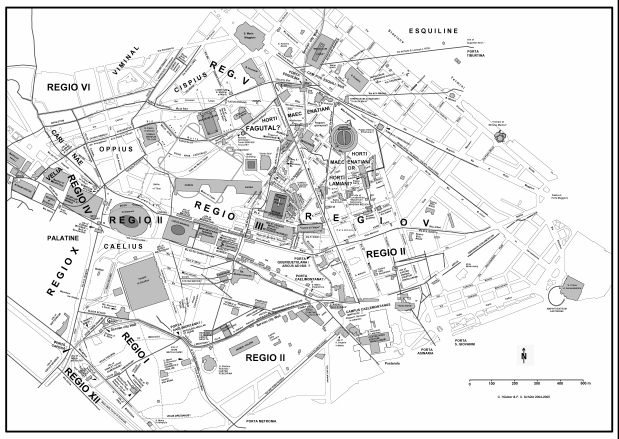
Abb. 1. Arbeitskarte: Esquilin und Caelius. Auf der Basis der photogrammetrischen Daten der Stadt Rom wurden die modernen Baublöcke (ital.: Isolati) digitalisiert (zur leichteren Orientierung sind Brunnen, Denkmäler, Edicole, Grünanlagen, Obelisken und `Verkehrsinseln´ mit erfaßt). In diese sind eingetragen: Antike Architekturen (graue Flächen; dunkelgraue Flächen innerhalb dieser Architekturen kennzeichnen Freiflächen), ausgegrabene antike Straßen und Straßen aus der `Großen Romkarte´ von G.B. Nolli (1748); es handelt sich um jene Straßen, die antiken Straßen entsprechen, sowie um die, mit deren Hilfe sich antike Befunde lokalisieren lassen (3 m breite schwarze Linien), antike Straßen, rekonstruiert (gestrichelte graue Linien), noch erhaltene bzw. in Ausgrabungen dokumentierte Teilstücke der Servianischen Stadtmauer (4 m breite hellgraue Linien), rekonstruierter Verlauf der Servianischen Stadtmauer (4 m breite dunkelgraue Linien). Antike Namen, Namen von Hügeln und Gewässern, von wichtigen archäologischen Befunden und von modernen Stadttoren sind in Großbuchstaben geschrieben. Antike Namen in moderner Schreibweise und moderne Namen erscheinen in Groß- und Kleinschreibung. Wenn antike Namen in Anführungszeichen gesetzt sind, ist entweder ihre Identifizierung nicht gesichert, oder es handelt sich um pseudoantike Toponyme. Wenn ein antiker Name mit einem Fragezeichen versehen ist, wird die Identifizierung von mir zur Diskussion gestellt. Chrystina Häuber und Franz Xaver Schütz 2004-2005, Rekonstruktion.
Abb. 1 ist nach S. 10 eingeheftet.
Die "Bildunterschrift" befindet sich auf Seite 59.
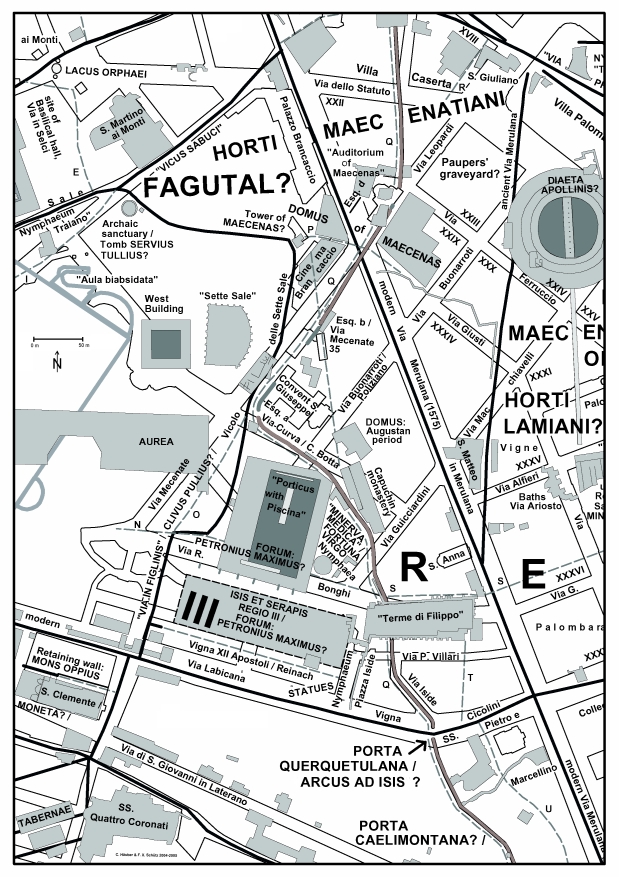
Abb. 1(a). Vergrößertes Detail von Abb. 1. Arbeitskarte: Esquilin und Caelius. Chrystina Häuber und Franz Xaver Schütz 2004-2005, Rekonstruktion.
Seite 11
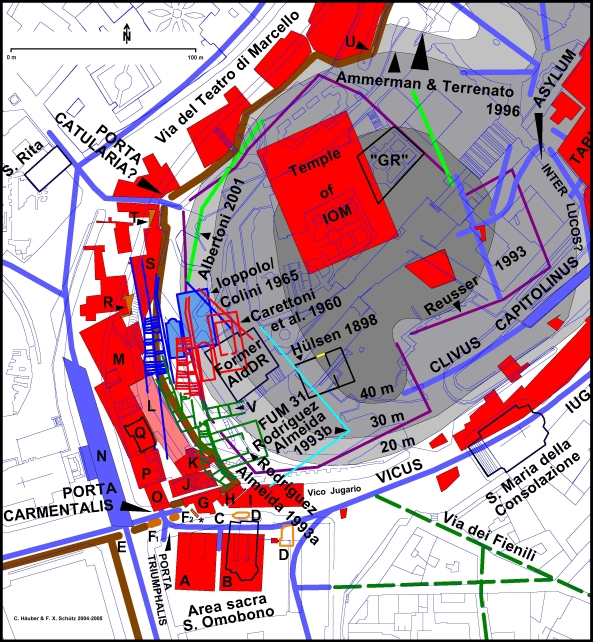
Abb. 2. Arbeitskarte: Kapitol. Vorstufe zu Abb. 5. Chrystina Häuber und Franz Xaver Schütz 2004-2005, Rekonstruktion.
Seite 17
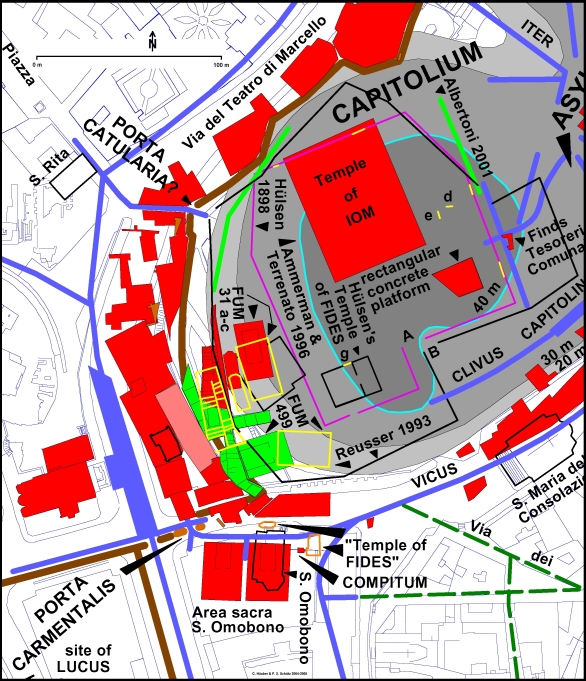
Abb. 3. Arbeitskarte: Kapitol. Vorstufe zu Abb. 5. Chrystina Häuber und Franz Xaver Schütz 2004-2005, Rekonstruktion.
Seite 21
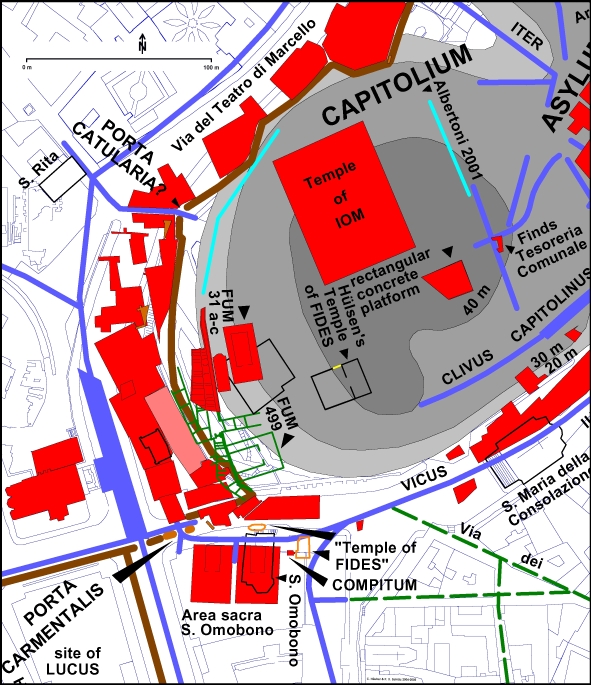
Abb. 4. Arbeitskarte: Kapitol. Vorstufe zu Abb. 5. Chrystina Häuber und Franz Xaver Schütz 2004-2005, Rekonstruktion.
Seite 25
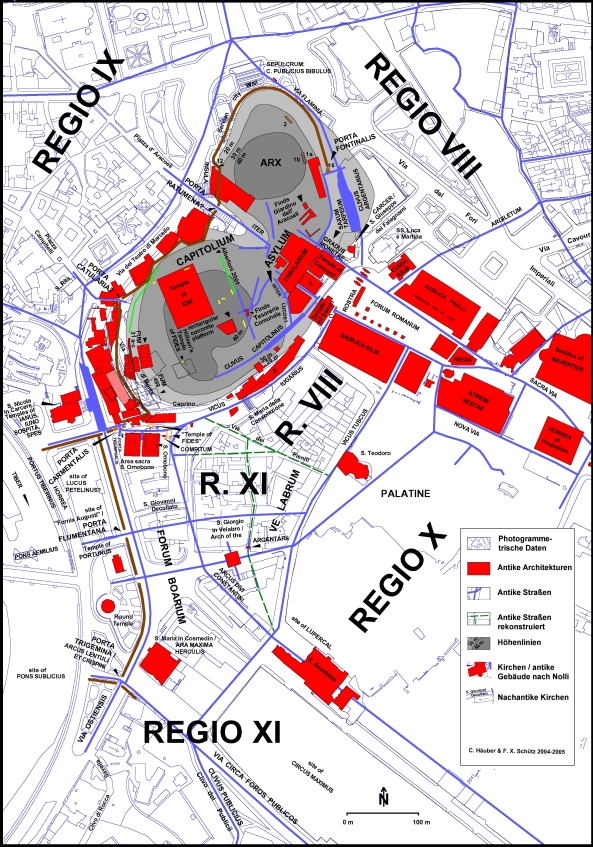
Abb. 5. Arbeitskarte: Kapitol. Die antiken Straßen und Architekturen sind in die photogrammetrischen Daten der Stadt Rom integriert. Die Höhenlinien wurden nach Ammerman und Terrenato (1996) eingezeichnet. Chrystina Häuber und Franz Xaver Schütz 2004-2005, Rekonstruktion.
Seite 29
Datenschutzerklärung | Impressum